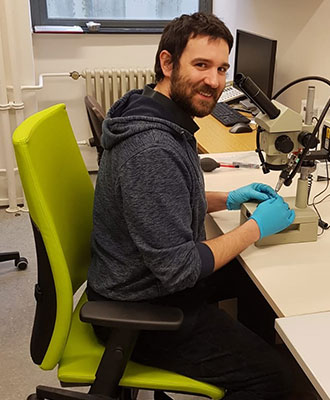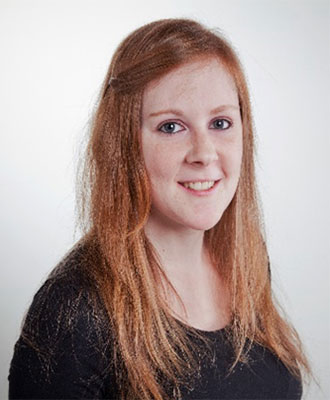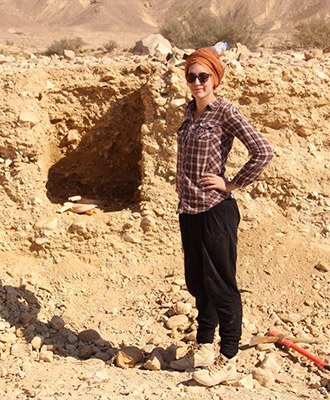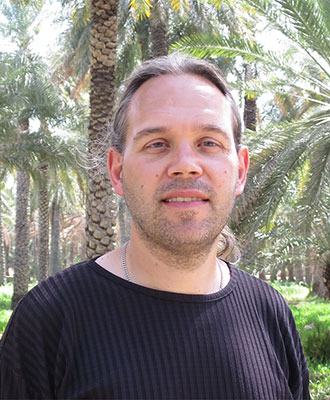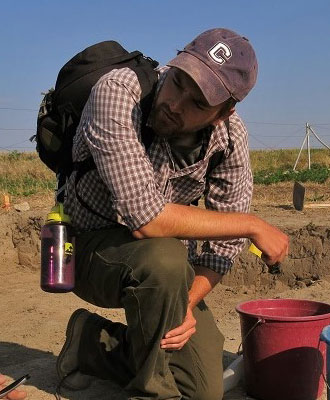Investigating this complex topic is an interdisciplinary research team of five scientists from four different universities, who are all experts in their respective field: Dr. Conrad Schmidt, an archaeologist from the Eberhard Karls University of Tübingen, coordinates the project. He has been working in Oman for more than ten years, studying the material culture of the Bronze Age. Joining him is Dr. Tara Beuzen-Waller, a geoarchaeologist from the University of Tübingen. She wants to discover when and how the people of Oman first started to use irrigation systems.
Dr. Lucas Proctor from the Goethe University of Frankfurt is exploring how people interacted with the natural world around them during the Bronze Age. The archaeobotanist studies archaeological plants and wood remains to learn more about the use of fuels during that time. Dr. Julia Unkelbach from the Georg-August University of Göttingen focuses on vegetation: She specializes in pollen, spores and other biological proxies in sedimentological archives to reconstruct past environments. Her work is complemented by that of Dr. Eric Otto Walliser from the Johannes Gutenberg University of Mainz, who is examining snail shells to reconstruct past climate conditions.
The multidisciplinary teamwork also helps to strengthen the network between a small discipline like Near Eastern Archaeology and other disciplines, such as Biology and Geology. Together the researchers hope to gain innovative insights into the landscape of the Bronze Age and deliver valuable findings on the sustainability strategies used by the people of Central Oman. A better understanding of the interactions between humans and their environment in the past might also provide new ideas for current debates on climate and the Environment.
1. What do you learn from your research about ancient environments/cultures that you find useful for today?
Eric: Little changes in the boundary conditions can trigger huge climate changes on the planetary scale, so we need to be careful.
Julia: Effective vegetation management is very important for preserving natural vegetation and landscape diversity, especially in extremely arid environments like the Sultanate of Oman.
Tara: I have learned that past societies faced similar challenges to those we face today (climate change, environmental degradation, political instability) but on smaller scales. I think it is vital to restore this knowledge, to extract the best from it and to learn from the mistakes that our ancestors made. Our work can contribute to building historical feedback about humans and environmental relations. Today the main topic in Oman is water scarcity, because an arid climate dominates the area. But several million years ago, the climate was more humid and water resources were well distributed and more accessible. The end of this humid period and the onset of the current arid climate is characteristic of the Bronze Age. It was a period of major environmental change, which early populations of this age had to face. Irrigation systems probably appeared during this period. We want to rebuild the timescale of this discovery that led to the onset of oases.
Conrad: Studying how societies managed to adapt to the environment and reacted to climate changes in the past can be helpful for our current challenges posed by anthropogenic climate change. We can learn how people’s way of life, subsistence and sustainability strategies are connected to the fragile environment.
Lucas: I think it is useful to see how creative and practical people were in the past in terms of living in challenging environments. They were able to adapt to heat, aridity and a lack of vegetation without many of the industrial technologies that we rely on today.
2. What are you aiming to find out during this Project?
Eric: I aim to reconstruct the changes in seasonality that people in Oman faced during the Bronze Age. Was seasonality stronger or weaker than today? Did climate change drive the demise of these societies? These are the two main questions that I will address.
Julia: I would be incredibly happy to do pioneering work on pollen-based vegetation and climate reconstruction in the piedmont/wadi region south of the Hajar Mountains. It will be challenging.
Tara: I want to work more carefully on ditches built around Bronze Age sites. I suspect that these structures played a key role in water supply.
Conrad: I hope the project’s results will provide a better understanding of how people reacted to past environmental and climate change as well as what consequences this had for the social organization of the society and sustainability strategies implemented.
Lucas: I would like to learn about the range of fuel resources used during the Bronze Age and, in particular, how they satisfied fuel requirements for pyrotechnic activities like metallurgy.
3. What have other researchers from your field already learned about the Bronze Age in Oman?
Eric: Well, not much. From earlier studies we know that climate conditions over the entire region were slightly wetter than today, but that’s basically it.
Julia: There was presumably a decline in climatic conditions (more arid and warmer) during the Bronze Age that forced the settlers to abandon agriculture and adopt a nomadic Lifestyle.
Tara: We learned that flow control certainly appeared at the end of the Neolithic, in the upstream part of the Hajar Mountain piedmont, so in a more humid context. We are in the downstream part of the piedmont, so it is a good opportunity to compare our data with that obtained upstream.
Conrad: We know that the Bronze Age in Central Oman was a period of fundamental changes in terms of subsistence strategies, resource exploitation and social complexity. Still, there are many open questions, especially about human interaction with the ecosystem, such as water management, which remain as topical as ever.
Lucas: Archaeobotanists have been able to track the use of wild and possibly domesticated date palm and other crops in Omani oases during the Bronze Age.
4. What makes Oman an interesting place to do Research?
Eric: Paleoclimatic studies have essentially neglected the interior of Oman for historical and logistics reasons, so there is lots of material out there to work with and plenty of new stuff to discover.
Julia: Palaeoenvironmental and palaeoclimatic work in the region is very sparse, so there is still a lot to discover about Holocene vegetation and climate dynamics in the Sultanate of Oman.
Tara: Oman is a very peaceful and stable place and that is quite exceptional in the Middle East. The Omani people are very welcoming and interested in our research, so it is comfortable to work with them. Interest in Oman is quite new from an archaeological point of view, starting at the end of the 1970s, so there is still a lot of work to be done.
Conrad: Due to the special climate, landscape and vegetation in Central Oman, there is very little soil accumulation. This means that, unlike in most regions of the world, archaeological layers are situated directly beneath modern Surface.
Lucas: The region has a rich history of settlement shaped deeply both by its environmental context and its proximity to other important centers such as Mesopotamia and Iran.
5. What challenges might you face during the Project?
Eric: I think the biggest challenge of this project will be time. Based on the preliminary data, I can already tell that there are so many directions worth investigating; I’m afraid that I could potentially spend my entire life on this project.
Julia: Finding suitable sedimentological archives for pollen analysis.
Tara: Like always: the sun.
Conrad: One challenge is that the excavation results are always unpredictable. We never know in advance if we will find the material that we are looking for. That is why it is important to apply a range of different methods from various disciplines in this project. If one method is less fruitful than expected, others will compensate.
Lucas: You never know if you will find enough charcoal to say something meaningful about the lives of people in the past until after you begin.


